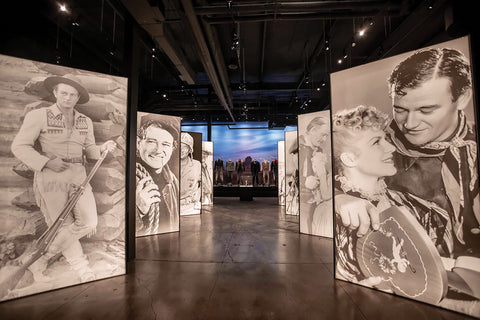
John Wayne Is Big As Life in This Fort Worth Museum
For his role as U.S. Marshal Rooster Cogburn in the 1969 film
True Grit the actor took home that year 's best actor Academy Award — long
overdue, contend his fans. (John Wayne: An American Experience, Fort Worth,
Texas)
Every aficionado of Hollywood Westerns produced from the 1930s to the ’70s has experienced the commanding screen presence of American actor John Wayne (May 26, 1907—June 11, 1979). His innumerable fans miss him, of course. Now, in addition to watching small-screen airings of such classic Wayne films as Stagecoach (1939), Red River (1948), The Searchers (1956), The Man Who Shot Liberty Valance (1962) and The Shootist (1976), they can revel in memories of him at John Wayne: An American Experience, a 10,000-square-foot exhibit space that opened in Fort Worth, Texas, on May 26, 2021, the 114th anniversary of his birth. Wayne’s youngest son, Ethan (see related interview), founded the museum, which provides an intimate look at the life of the man born Marion Robert Morrison in Winterset, Iowa, who became celebrated worldwide as “Duke” (a nickname inspired by a beloved Airedale terrier Wayne had as a child).
Visitors begin their experience with an introductory video at the in-house theater, enjoying clips from Duke’s many films while narrator Ethan maps out the museum. Spanning nine rooms, the exhibit delves into Wayne’s career and personal life and features more than 400 artifacts, making it the largest collection of the actor’s memorabilia on public display.
Wayne grew up in Southern California. Discovered by director John Ford while working as a prop boy in Hollywood, Duke was doing stunts and appearing in bit parts by his early 20s. Lining either side of the main exhibit space are eight larger-than-life lighted monoliths depicting Wayne in various films, from his first starring appearance in The Big Trail (1930) to The Shootist , his final role before his 1979 death. On the reverse of each is background information about his various roles. Monitors attached to four monoliths and along an adjacent wall show iconic moments from his scores of films. Wayne appeared in upward of 140 films, including 80 Westerns. He took his craft seriously and later produced and directed films in which he and other leading Western actors starred. One panel deals with his approach to acting. Myriad artifacts, including scripts, props and costumes, will please the fans of a man who once said, “Nobody should come to the movies unless he believes in heroes.”
Among the many entertaining exhibits
is a gallery of costumes Wayne wore in films, including these familiar cowboy
duds. (John Wayne: An American Experience, Fort Worth, Texas)
Wayne, who stood a strapping 6-foot-4 and spoke with an unmistakable drawl, certainly played the hero while defining the role of the American cowboy. He upholds law and order in such films as Rio Bravo (1959) and its reprise, El Dorado (1966), both directed by Howard Hawks. Wayne serves his country in uniform in Ford’s “cavalry trilogy”— Fort Apache (1948), S he Wore a Yellow Ribbon (1949) and Rio Grande (1950). In his 1960 directorial debut, The Alamo , he plays frontier legend Davy Crockett. In several notable instances Wayne’s heroic character shows his flaws—in The Searchers he evinces a hatred for Indians, while in Red River he descends into paranoid mania during a cattle drive and nearly kills his adopted son, played by Montgomery Clift. Even as U.S. Marshal Rooster Cogburn in True Grit (1969)—the role that finally earned him a best actor Oscar, which holds a place of honor in the exhibit—he is ornery, drinks too much and seems all too eager to pull the trigger on badmen.
Capping off the highlights is this gallery
of 16 of Duke's co-starring hats, from Stetsons to fedoras. (John Wayne: An
American Experience, Fort Worth, Texas)
Wayne wore many hats on-screen, and 16 of them, from Stetsons to fedoras, are on display in the interactive “Step Into My Shoes” gallery, which allows visitors to “co-star” with him in three scenes. The “Walk the Walk, Talk the Talk” gallery captures Duke at the height of his stardom as both a full- fledged American hero and an international film star. Featured footage includes praise of Wayne from some of film and television’s greatest stars. A video cabinet presents 38 pop culture clips, including cartoons and comic strips, that reference the screen legend. Another gallery celebrates him as “A Man of the People,” one who interacted warmly with fans, service members and presidents alike. The most personal display centers on the Wayne family, which chose photos and correspondence that further illumine the Western icon.
Tomorrow is the most important thing in life. Comes into us at midnight very clean. It's perfect when it arrives and it puts itself in our hands. It hopes we've learned something from yesterday
Headstone epitaph, John Wayne (1907–79)
Open seven days a week, John Wayne: An American Experience is at the heart of the Fort Worth Stockyards, in the Historic Exhibits Building near the corner of Rodeo Plaza and East Exchange Avenue. For more information call 628-224-0956. WW
this article first appeared in wild west magazine
Facebook @WildWestMagazine | Twitter @WildWestMag
